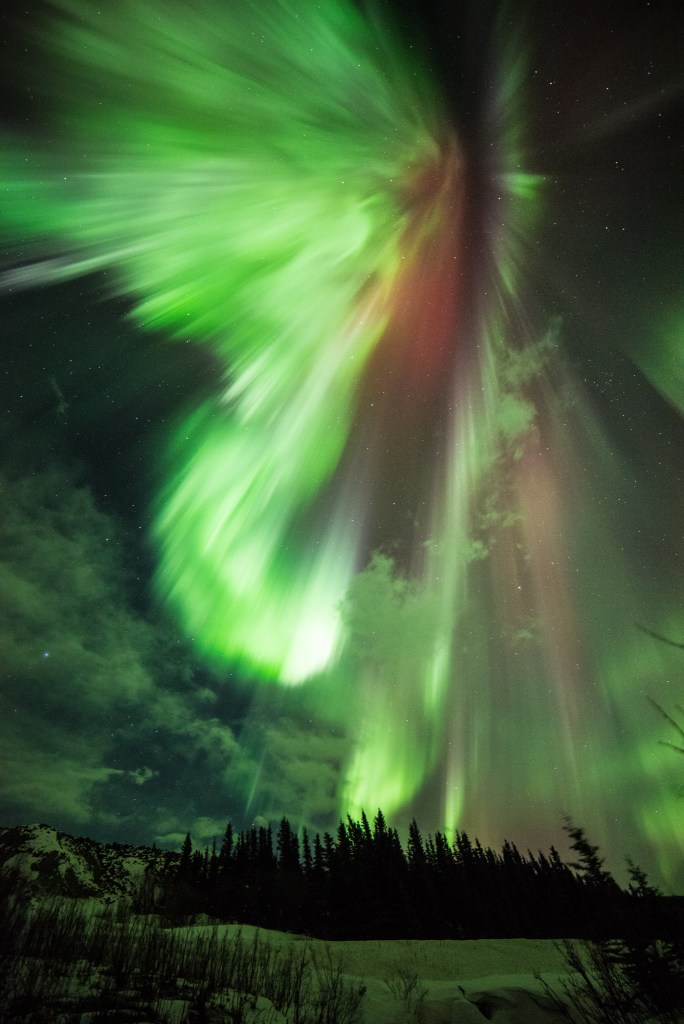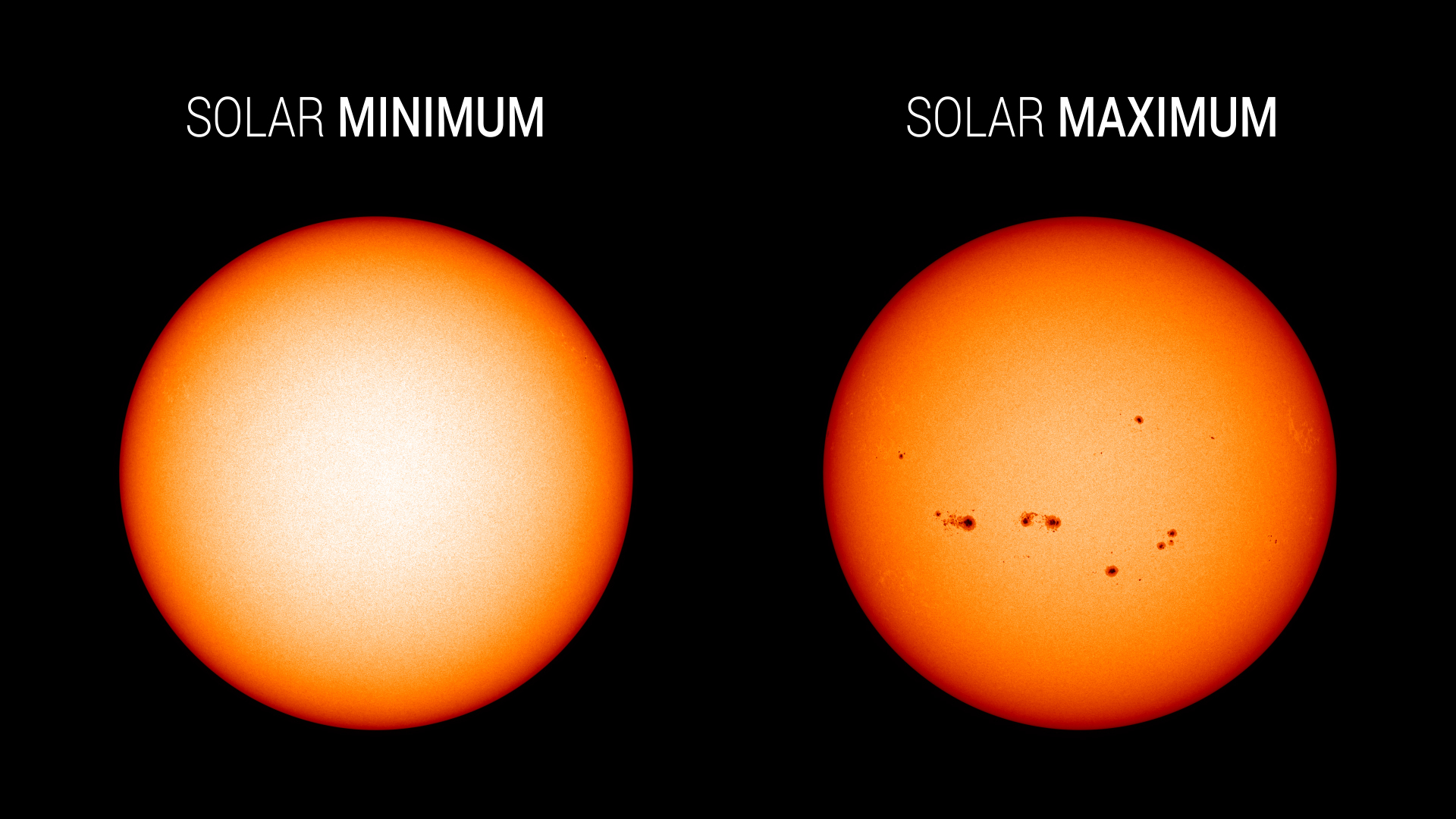The Sun is stirring from its latest slumber. As sunspots and flares, signs of a new solar cycle, bubble from the Sun’s surface, scientists wonder what this next cycle will look like. The short answer is, probably a lot like the last — that is, the past 11 years of the Sun’s life, since that’s the average length of any given cycle. But the longer story involves a panel of experts that meets once a decade, a fleet of Sun-studying satellites, and dozens of complicated models — all revolving around efforts to understand the mystifying behavior of the star we live with.
NASA scientists study and model the Sun to better understand what it does and why. The Sun has its ups and downs and cycles between them regularly. Roughly every 11 years, at the height of this cycle, the Sun’s magnetic poles flip — on Earth, that’d be like if the North and South Poles swapped places every decade — and the Sun transitions from sluggish to active and stormy. At its quietest, the Sun is at solar minimum; during solar maximum, the Sun blazes with bright flares and solar eruptions.
Solar cycle predictions give a rough idea of what we can expect in terms of space weather, the conditions in space that change much like weather on Earth. Outbursts from the Sun can lead to a range of effects, from ethereal aurora to satellite orbital decay, and disruptions to radio communications or the power grid. NOAA’s Space Weather Prediction Center is the U.S. government’s official source for space weather forecasts, watches, warnings, and alerts: With accurate predictions, we can prepare.
The work that researchers at NASA and around the world do to advance our solar activity models helps improve those forecasts. In turn, solar cycle forecasts give us a sense of how stormy the Sun will be over the next 11 years and how much radiation spacecraft and astronauts may face during heavy bouts of solar activity.
Credits: NASA’s Goddard Space Flight Center
Download this video in HD formats from NASA Goddard’s Scientific Visualization Studio
Modeling the Sun is a tricky business because scientists don’t fully understand the internal churning that causes this magnetic flip-flop. Computer models use equations to represent the Sun, but the star manages to elude them. If the Sun were a machine, it would have countless knobs and dials whose functions and sensitivities remain unknown.
“Over the last 40 years, we’ve come to observe the Sun in much greater detail,” said Lika Guhathakurta, program scientist of the Heliophysics Division at NASA Headquarters. “It’s produced a wealth of information, but quantifying and modeling the solar cycle remains challenging. We’re working against how variable the Sun is, and the complexity of what happens inside the Sun.”
Without fully understanding how the magnetic field, which drives solar activity, moves inside the Sun, scientists have to make some assumptions. The plight of solar modelers could be likened to that of weather forecasters — if they tried to forecast the weather by looking at just the upper atmosphere, and not the critical layers below.
There are many approaches to modeling the Sun in order to develop solar cycle predictions. Some models use ground-based observations spanning hundreds of years; others may use satellite data, which has only been available for the past four decades or so. In recent years, some researchers have incorporated machine-learning tactics. Models may focus on different precursors scientists have identified are linked to solar activity: Earth’s magnetic field, which responds to the Sun’s, and the strength of the magnetic field at the Sun’s poles are most common.
“Part of the scientific process is whittling these questions down, and working in parallel on the same problem in different ways,” said Maria Weber, an astrophysicist at Delta State University in Cleveland, Mississippi. Each model is one tool among many. “We might find there are different tools that can get us the same outcome, and then you could pick the type that best suits you.”
It’s the job of the Solar Cycle Prediction Panel — co-sponsored by NASA and NOAA, the National Oceanic and Atmospheric Administration — to evaluate all of these models and release an official prediction representing the scientific community’s best efforts. Meeting every decade since 1989, the panel brings together experts from around the world, including Weber, who served on the panel for Solar Cycle 25. The discussions are known to occasionally get heated, a sign of the complex task at hand and the fervor each scientist has for their favorite models.
In the end, the scientists wrote their predictions on a little piece of paper, Weber said, and the debating began. “Ultimately, we all had to agree, whittling down and adjusting our estimates, so that people felt it best reflected everything we knew up to that point,” she said.
In March 2019, only the fourth time such a panel had convened, the 12 experts considered some 60 different models. In recent years, one seems to be especially successful: the polar magnetic field model. This uses measurements of the magnetic field at the Sun’s north and south poles. The idea is that the magnetic field at the Sun’s poles acts like a seed for the next cycle. If it’s strong during solar minimum, the next solar cycle will be strong; if it’s diminished, the next cycle should be too.
Together, they predicted dates for Cycle 25’s start and peak, and the peak sunspot number, an indicator of how strong the cycle will be. The more sunspots, the higher the sunspot number, and the more solar eruptions a cycle is expected to unleash.
Currently, the Sun’s poles are about as strong as they were at the same point in the last solar cycle, which scientists interpret as signs that Solar Cycle 25 will play out in similar fashion to Cycle 24. Solar Cycle 24 was a feeble cycle, peaking at 114 sunspots (the average is 179). Solar Cycle 25 is now underway and expected to peak with 115 sunspots in July 2025.
Lisa Upton, co-chair of the Solar Cycle 25 Prediction Panel and solar physicist at Space Systems Research Corporation in Westminster, Colorado, compared their task to hurricane forecasting. Meteorologists often consult several models, each spitting out its own possible path a hurricane could take. “One of the lessons there is you don’t put too much faith in one model, but see what all of the models together can tell you and teach you,” Upton said. As a whole, a group of predictions is more likely to land on the right path.
Some have taken novel approaches to making these predictions. Scientists recently published a new way to survey the solar cycle: Instead of the traditional linear view of time, they used a mathematical technique to map the last 18 solar cycles onto a circle. What emerged was a more orderly pattern of behavior than expected from the Sun.
Their so-called solar clock is like a typical clock, where each roughly 11-year cycle can be described over 12 hours. Instead of the time of day, certain “times” correspond to high solar activity. Right now, the scientists say, it’s about 3 o’clock, near the first uptick in activity that comes at the beginning of each solar cycle. The scientists reported their findings in Geophysical Research Letters.
“The most active Sun — in terms of solar eruptions — happens between 5:30 and about 10:00, when there’s a sharp drop-off in activity as the Sun moves toward minimum,” said Robert Leamon, a solar scientist on the study, based at NASA’s Goddard Space Flight Center in Greenbelt, Maryland. “Once we know where we are on the solar clock and can calculate the speed of the cycle we’re in, we can make much more precise predictions about when the next cycle of solar activity will start and stop.”
According to their clock, the Sun’s next quiet period will begin around the first half of 2027.
If Solar Cycle 25 meets the panel’s predictions, it should be weaker than average. Cycle 25 is also expected to end a longer trend over the past four decades, in which the magnetic field at the Sun’s poles were gradually weakening. As a result, the solar cycles have been steadily weaker too. If Solar Cycle 25 sees an end to this waning, it would quell speculations that the Sun might enter a grand solar minimum, a decades-to-centuries long stretch of little solar activity. The last such minimum — known as the Maunder minimum — occurred in the middle of what’s known as the Little Ice Age from the 13th to 19th centuries, causing erroneous beliefs that another grand minimum could lead to global cooling.
“There is no indication that we are currently approaching a Maunder-type minimum in solar activity,” Upton said. But even if the Sun dropped into a grand minimum, there’s no reason to think Earth would undergo another Ice Age; not only do scientists theorize that the Little Ice Age occurred for other reasons, but in our contemporary world, greenhouse gases far surpass the Sun’s effects when it comes to changes in Earth’s climate.
Eventually, scientists would like to issue weekly forecasts for the Sun, just like meteorologists do for Earth. But solar cycle and space weather forecasting have far to go. There are still questions about the Sun’s interior to answer and important data to collect.
“One of the things that’s exciting about being a solar physicist is that we’re at the forefront of this — there’s still all these questions that have yet to be answered,” Upton said. “There are still a lot of rocks to unturn.”
Solar Cycle 25 will continue to unfold, and scientists will keep tinkering with their models and watching to see how close their predictions come. It will be another five to six years before they can say who was right — or wrong — all along.
Related:
- Analysis Determines We Are in Solar Cycle 25
- Solar Cycle 25 Is Here. NASA, NOAA Scientists Explain What That Means
- How Scientists Around the World Track the Solar Cycle
By Lina Tran
NASA’s Goddard Space Flight Center, Greenbelt, Md.



























